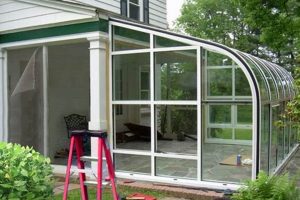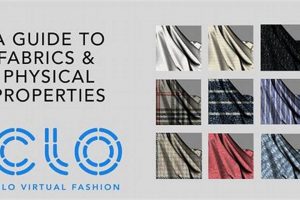These readily available sets contain the necessary components for property owners to independently install a thermal barrier. Typically, such a package includes the insulating material itself, application tools, and safety equipment. These are designed to allow individuals to enhance the energy efficiency of their residences without professional assistance.
Undertaking such a project offers potential cost savings on labor expenses, and increased control over the insulation process. Historically, insulation projects were solely the domain of skilled tradespeople. However, technological advancements and simplified application methods have empowered individuals to manage these home improvement tasks themselves, contributing to improved thermal comfort and potentially lower energy consumption.
The subsequent sections will address the various types of insulation materials available in these packages, the safety precautions necessary during installation, and the factors to consider when determining the suitability of a do-it-yourself approach for specific insulation needs.
Application Guidance
Effective implementation of these systems necessitates careful planning and adherence to safety protocols. The following guidance aims to optimize the process and ensure a successful outcome.
Tip 1: Surface Preparation: Prior to commencing application, ensure the target surface is clean, dry, and free of debris. This promotes optimal adhesion and maximizes the insulating effectiveness.
Tip 2: Environmental Conditions: Temperature and humidity can significantly impact expansion and curing times. Consult the manufacturer’s specifications for recommended application parameters and avoid installation during extreme weather.
Tip 3: Proper Mixing: Thoroughly combine the components according to the provided instructions. Inadequate mixing can result in inconsistent density and diminished thermal performance.
Tip 4: Consistent Application: Maintain a steady and uniform spray pattern to achieve the desired thickness and avoid voids or uneven coverage. Overlap each pass slightly for comprehensive insulation.
Tip 5: Ventilation: Ensure adequate ventilation during and after application to mitigate exposure to fumes and facilitate proper curing. Use appropriate respiratory protection as directed.
Tip 6: Safety Equipment: Always wear personal protective equipment, including gloves, eye protection, and a respirator, to minimize the risk of skin irritation, eye damage, and respiratory distress.
Tip 7: Curing Time: Allow sufficient curing time before exposing the insulated area to moisture or mechanical stress. Refer to the manufacturer’s guidelines for specific curing durations.
Adhering to these recommendations will contribute to a properly insulated structure, offering improved energy efficiency and enhanced comfort.
The concluding section will summarize the advantages of this method of insulation and provide resources for further information.
1. R-Value
R-value, a measure of thermal resistance, is a critical factor when evaluating foam insulation offerings. Higher R-values indicate greater resistance to heat flow, resulting in improved energy efficiency. The R-value of a given product directly impacts its ability to reduce heating and cooling costs. For example, a property owner in a cold climate seeking to minimize heat loss through exterior walls would benefit from selecting a product with a higher R-value per inch of thickness.
Different types of insulation materials possess varying R-values. Closed-cell options, commonly found in kits, generally offer higher R-values compared to open-cell formulations. Furthermore, the application method and proper installation techniques directly influence the realized R-value. An improperly applied layer with gaps or inconsistencies will not perform to its rated specifications. Therefore, adherence to manufacturer guidelines is essential to achieve the desired thermal performance.
In summary, the R-value is a fundamental consideration when choosing DIY insulation solutions. While the convenience of a kit is appealing, understanding the material’s thermal resistance and its proper implementation are paramount to realizing the intended energy savings and comfort benefits. Selecting a product with an appropriate R-value for the specific climate and application is a critical step in the process.
2. Application method
The success of do-it-yourself insulation hinges significantly on the application method. These kits typically employ either a spray foam or an injection method, each dictating the equipment required, the level of skill necessary, and the suitability for various insulation projects. Improper application directly correlates with diminished thermal performance, potential structural damage, and health hazards. Spray options, for instance, require careful technique to ensure uniform coverage and avoid overspray. Incorrect injection can lead to uneven distribution and compromised insulation effectiveness.
Real-world examples illustrate the practical significance of understanding the application method. Consider insulating wall cavities: spray foam is often preferred due to its ability to expand and fill gaps, creating a tight seal. However, in enclosed spaces, proper ventilation is critical to prevent the accumulation of harmful fumes. Conversely, injection is useful for insulating existing walls without extensive demolition but demands precision to avoid overfilling and potential damage to the wall structure. Therefore, matching the application method to the specific project is essential for optimal results.
In conclusion, the application method is not merely a procedural step but a core component influencing the outcome of any DIY insulation project. Understanding the nuances of each method, adhering to safety guidelines, and matching the application to the specific insulation task are crucial for achieving desired energy efficiency and avoiding potential pitfalls. Failure to prioritize this aspect can negate the benefits and incur unnecessary expenses or even health risks.
3. Curing Time
Curing time represents a critical, often overlooked, parameter within the context of do-it-yourself insulation projects. This refers to the duration required for the applied material to fully solidify, stabilize, and achieve its intended physical and chemical properties. Adequate curing is essential for optimal thermal performance and long-term durability.
- Impact on Insulation Performance
Insufficient curing time can lead to compromised insulation effectiveness. Premature exposure to temperature
fluctuations or physical stress before complete curing may result in shrinkage, cracking, or incomplete expansion of the foam. This, in turn, creates gaps and reduces the insulation’s R-value, negating intended energy-saving benefits. For instance, if a homeowner installs insulation in an attic and immediately covers it with flooring before full curing, the insulation’s performance will be severely compromised. - Off-Gassing Considerations
Many formulations release volatile organic compounds (VOCs) during the curing process. Insufficient curing time may result in prolonged off-gassing, potentially impacting indoor air quality. These VOCs can pose health risks, particularly in poorly ventilated areas. Therefore, adhering to the manufacturer’s recommended curing period and ensuring adequate ventilation are paramount to minimizing exposure and safeguarding occupant health.
- Structural Integrity Implications
In certain applications, the insulation contributes to structural integrity. For example, closed-cell varieties are sometimes used to enhance the rigidity of walls. However, if the foam is not fully cured, it will not provide the intended structural support, potentially compromising the building’s stability. Premature loading or disturbance of the uncured insulation can lead to permanent deformation and reduced structural performance.
- Adhesion and Long-Term Durability
Proper curing ensures optimal adhesion of the insulation to the substrate. Premature exposure to moisture or mechanical stress can weaken the bond, leading to delamination and reduced long-term durability. This is particularly relevant in damp environments, where poor adhesion can foster mold growth and accelerate material degradation. A well-cured application resists degradation and maintains its insulating properties over time.
In summary, curing time is an integral aspect of successfully implementing foam insulation systems. Adhering to the manufacturer’s guidelines for curing duration is not merely a procedural detail but a crucial step in ensuring optimal performance, mitigating health risks, enhancing structural integrity, and maximizing the long-term durability of the installed insulation.
4. Safety Measures
The integration of safety measures is not merely a recommendation but a mandatory requirement when engaging with insulation applications. These packages contain chemical compounds that, without proper handling, pose significant health risks. Direct skin contact can result in irritation or sensitization, while inhalation of fumes can cause respiratory distress or long-term health problems. Eye exposure may lead to severe damage. Therefore, these kits must include comprehensive safety instructions and the necessary protective equipment to mitigate these hazards. Real-world examples consistently demonstrate that neglecting these safety measures results in adverse health outcomes, ranging from minor skin rashes to severe respiratory illnesses requiring medical intervention. The absence of adequate safety protocols transforms an energy-saving endeavor into a potential health liability.
The practical significance of understanding and implementing safety measures extends beyond personal well-being. Incomplete or improper safety precautions can lead to environmental contamination and property damage. For instance, inadequate ventilation during application can cause the buildup of flammable fumes, increasing the risk of fire or explosion. Furthermore, improper disposal of leftover materials can contaminate soil and water sources. Therefore, safety measures encompass not only personal protection but also responsible environmental stewardship. Adherence to disposal guidelines and proper ventilation protocols are critical to minimizing the environmental footprint of these insulation projects.
In summary, safety measures are inextricably linked to the responsible and effective use of do-it-yourself insulation solutions. The potential risks associated with these materials necessitate a comprehensive understanding and strict adherence to safety guidelines. Prioritizing safety is not a cost-cutting option but an ethical and legal obligation. Individuals undertaking such projects must equip themselves with adequate knowledge, appropriate protective gear, and a commitment to responsible handling and disposal practices to ensure their well-being and protect the environment.
5. Cost Efficiency
An evaluation of the financial viability of DIY foam insulation solutions necessitates a thorough examination of upfront costs against potential long-term savings. The initial investment encompasses the price of the kit itself, including the insulating material, application equipment (if not reusable), and essential safety gear. This upfront expenditure must be juxtaposed with the anticipated reduction in energy consumption, translating to lower heating and cooling expenses over the lifespan of the insulation. A homeowner must consider factors such as climate, existing insulation levels, and the energy efficiency of the property to accurately project potential savings. For example, a poorly insulated attic in a region with extreme temperature fluctuations will likely yield a higher return on investment compared to a well-insulated home in a temperate climate.
Furthermore, a comprehensive cost analysis should account for the potential for errors and rework. Inexperienced installers may encounter challenges such as uneven application, material wastage, or structural damage, leading to additional expenses to rectify these issues. Conversely, professional installation, while incurring higher initial labor costs, often minimizes these risks due to the expertise and experience of trained technicians. A homeowner must therefore weigh the potential cost savings of DIY installation against the risk of incurring additional expenses due to mistakes. The long-term performance and durability of the insulation also play a pivotal role in cost efficiency. Higher-quality materials and proper installation translate to a longer lifespan and reduced maintenance costs. Therefore, selecting a reputable product and adhering to manufacturer guidelines are essential for maximizing the return on investment.
In summary, achieving cost efficiency with these systems demands a holistic approach that extends beyond the initial purchase price. A thorough assessment of potential energy savings, the likelihood of installation errors, and the long-term durability of the insulation is crucial for making an informed decision. While DIY installation offers the potential for cost savings, it also carries inherent risks that must be carefully considered to ensure a financially sound and sustainable outcome. Neglecting to account for these factors can result in higher overall costs and diminished energy efficiency gains.
6. Coverage area
The coverage area of a foam insulation package directly dictates its suitability for specific insulation projects. This metric, typically expressed in square feet, indicates the surface area that a given kit is designed to insulate at a specified thickness. An insufficient coverage area necessitates purchasing additional kits, increasing project costs and potentially introduci
ng inconsistencies in material properties or application techniques. Conversely, acquiring a kit with excessive coverage results in unnecessary material waste, representing a financial inefficiency. Therefore, accurately assessing the area to be insulated is a critical preliminary step. For example, insulating a standard-sized attic typically requires several kits, whereas a small crawl space may be adequately addressed with a single package. Real-world scenarios underscore the importance of this calculation; misjudging the required coverage often leads to project delays and budget overruns.
Furthermore, the stated coverage area is often predicated on ideal application conditions and assumes a consistent layer thickness. Deviations from these conditions, such as uneven surfaces or imprecise application techniques, can significantly reduce the actual coverage achieved. In such cases, more material is required to attain the desired level of insulation, further emphasizing the need for accurate measurement and realistic estimations. Practical application reveals that overestimating the required coverage, while seemingly wasteful, is often preferable to underestimating, as it provides a buffer for potential errors and ensures adequate insulation across the targeted area. The ability to calculate the area is essential for determining the amount of materials required.
In summary, the coverage area is an indispensable consideration when selecting a do-it-yourself insulation solution. A precise calculation of the area to be insulated, coupled with a realistic assessment of potential application challenges, ensures that the chosen product is appropriately sized for the project. This proactive approach minimizes material waste, prevents project delays, and ultimately contributes to a cost-effective and thermally efficient outcome. Failure to adequately consider coverage can lead to inefficient outcomes.
Frequently Asked Questions
The following addresses common inquiries regarding do-it-yourself insulation applications, offering clarity on crucial aspects for prospective users.
Question 1: What level of expertise is required for the successful application of foam insulation systems?
Successful application necessitates a foundational understanding of building science principles and proficiency in operating the application equipment. While prior experience is beneficial, meticulous adherence to the manufacturer’s instructions is paramount.
Question 2: How does the R-value of DIY solutions compare to professionally installed alternatives?
The R-value is contingent upon the specific material composition and application technique. When implemented correctly, DIY options can achieve comparable R-values to professionally installed systems. However, inconsistencies in application can compromise performance.
Question 3: What are the potential health risks associated with handling these materials, and how can they be mitigated?
Potential health risks include respiratory irritation, skin sensitization, and eye damage. Mitigation strategies involve utilizing appropriate personal protective equipment, ensuring adequate ventilation, and adhering to recommended handling procedures.
Question 4: What is the typical lifespan of do-it-yourself insulation, and what factors influence its longevity?
The lifespan varies depending on material quality, environmental conditions, and installation quality. Generally, a properly installed system can maintain its thermal performance for several decades. Factors such as moisture exposure, physical damage, and UV radiation can accelerate degradation.
Question 5: How does the cost-effectiveness of DIY insulation compare to professional installation, considering both upfront expenses and long-term energy savings?
DIY installation typically offers lower upfront costs due to the elimination of labor expenses. However, long-term cost-effectiveness hinges on the quality of installation and the resulting energy savings. Improper installation can negate potential savings and lead to additional expenses for remediation.
Question 6: What are the proper disposal procedures for leftover materials and empty containers, and what environmental considerations should be observed?
Disposal procedures vary depending on local regulations and the specific chemical composition of the material. Typically, unused materials require disposal at designated hazardous waste facilities. Empty containers should be thoroughly emptied and properly sealed to prevent environmental contamination.
In summary, informed decision-making regarding this application method requires a comprehensive understanding of the associated risks, benefits, and best practices. Prioritizing safety, accuracy, and adherence to manufacturer guidelines is crucial for a successful and sustainable outcome.
The subsequent section will provide a comparative analysis of various commercially available products, highlighting their strengths, weaknesses, and suitability for different applications.
Conclusion
This exploration of foam insulation diy kits has illuminated the multifaceted considerations necessary for informed decision-making. The efficacy of these systems hinges upon a rigorous assessment of R-value, application method, curing time, safety measures, cost efficiency, and coverage area. A failure to adequately address each of these components can compromise the insulation’s performance, negate potential energy savings, and even pose health risks. Furthermore, adherence to manufacturer guidelines and a commitment to proper installation techniques are paramount to achieving the intended thermal benefits and ensuring long-term durability.
Ultimately, the decision to employ foam insulation diy kits requires a balanced evaluation of the potential advantages and inherent challenges. While the prospect of cost savings and increased control is appealing, prospective users must prioritize safety, accuracy, and a thorough understanding of the materials involved. Further research, careful planning, and a realistic assessment of one’s capabilities are essential prerequisites for a successful and sustainable outcome in this domain.







